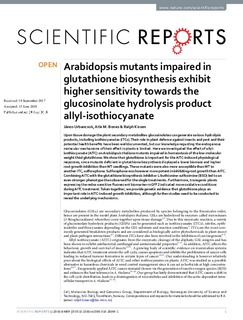| dc.contributor.author | Urbancsok, Janos | |
| dc.contributor.author | Bones, Atle M. | |
| dc.contributor.author | Kissen, Ralph | |
| dc.date.accessioned | 2018-07-10T07:15:58Z | |
| dc.date.available | 2018-07-10T07:15:58Z | |
| dc.date.created | 2018-06-16T10:43:12Z | |
| dc.date.issued | 2018 | |
| dc.identifier.issn | 2045-2322 | |
| dc.identifier.uri | http://hdl.handle.net/11250/2504892 | |
| dc.description.abstract | Upon tissue damage the plant secondary metabolites glucosinolates can generate various hydrolysis products, including isothiocyanates (ITCs). Their role in plant defence against insects and pest and their potential health benefits have been well documented, but our knowledge regarding the endogenous molecular mechanisms of their effect in plants is limited. Here we investigated the effect of allyl-isothiocyanate (AITC) on Arabidopsis thaliana mutants impaired in homeostasis of the low-molecular weight thiol glutathione. We show that glutathione is important for the AITC-induced physiological responses, since mutants deficient in glutathione biosynthesis displayed a lower biomass and higher root growth inhibition than WT seedlings. These mutants were also more susceptible than WT to another ITC, sulforaphane. Sulforaphane was however more potent in inhibiting root growth than AITC. Combining AITC with the glutathione biosynthesis inhibitor L-buthionine-sulfoximine (BSO) led to an even stronger phenotype than observed for the single treatments. Furthermore, transgenic plants expressing the redox-sensitive fluorescent biomarker roGFP2 indicated more oxidative conditions during AITC treatment. Taken together, we provide genetic evidence that glutathione plays an important role in AITC-induced growth inhibition, although further studies need to be conducted to reveal the underlying mechanisms. | nb_NO |
| dc.language.iso | eng | nb_NO |
| dc.publisher | Nature Publishing Group | nb_NO |
| dc.relation.uri | https://rdcu.be/14zZ | |
| dc.rights | Navngivelse 4.0 Internasjonal | * |
| dc.rights.uri | http://creativecommons.org/licenses/by/4.0/deed.no | * |
| dc.title | Arabidopsis mutants impaired in glutathione biosynthesis exhibit higher sensitivity towards the glucosinolate hydrolysis product allyl-isothiocyanate | nb_NO |
| dc.type | Journal article | nb_NO |
| dc.type | Peer reviewed | nb_NO |
| dc.description.version | publishedVersion | nb_NO |
| dc.source.volume | 8 | nb_NO |
| dc.source.journal | Scientific Reports | nb_NO |
| dc.identifier.doi | 10.1038/s41598-018-28099-1 | |
| dc.identifier.cristin | 1591649 | |
| dc.relation.project | Norges forskningsråd: 214329 | nb_NO |
| dc.description.localcode | © The Author(s) 2018. This article is licensed under a Creative Commons Attribution 4.0 International License. | nb_NO |
| cristin.unitcode | 194,66,10,0 | |
| cristin.unitname | Institutt for biologi | |
| cristin.ispublished | true | |
| cristin.fulltext | original | |
| cristin.qualitycode | 1 | |

